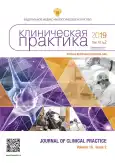Internal hernia as one of the causes of abdominal pain
- Authors: Kitaev V.M.1, Koshelev E.G.2,3, Sokolova O.V.1, Belyaev G.Y.2,4, Egorov A.A.4, Kurzantseva O.O.5,6
-
Affiliations:
- Institute of Advanced Medical Studies of the National Medical and Surgical Center of N.I. Pirogov
- Central State Medical Academy of the Office of the President of the Russian Federation
- City Clinical Hospital № 1 of. N.I. Pirogov
- «Polyclinic № 2» of the Office of the President of the Russian Federation
- Federal Scientific and Clinical Center of Specialized Types of Medical Care and Medical Technologies of the Federal Medical and Biological Agency of Russia
- City Clinical Hospital of S.P. Botkin
- Issue: Vol 10, No 2 (2019)
- Pages: 27-35
- Section: Original Study Articles
- URL: https://journals.rcsi.science/clinpractice/article/view/15199
- DOI: https://doi.org/10.17816/clinpract10227-35
- ID: 15199
Cite item
Full Text
Abstract
Abdominal pain is often observed in clinical practice, causing diagnostic difficulties for doctors of different specialties. Internal hernias are a surgical pathology and may be the cause for the development of acute small bowel obstruction and the occurrence of pain. A modern classification of internal hernias is presented and their topographic-anatomical description is given. The analysis of the results of computed tomography (CT) scan of the abdominal cavity in 20 patients with an unidentified cause of abdominal pain was performed. According to the CT data, three patients had internal hernias that caused the development of pain syndrome. A pathological displacement of intestinal loops with partial disruption of intestinal permeability and curvature of the mesentery without critical disturbance of blood supply was demonstrated in 4 patients with abdominal pain. The findings suggest that CT may be the method of choice when examining patients with an unknown cause of abdominal pain syndrome.
Full Text
##article.viewOnOriginalSite##About the authors
V. M. Kitaev
Institute of Advanced Medical Studies of the National Medical and Surgical Center of N.I. Pirogov
Email: vm_kitaev@list.ru
д-р мед. наук, профессор, зав. кафедрой лучевой диагностики с курсом клинической радиологии
Russian Federation, MoscowE. G. Koshelev
Central State Medical Academy of the Office of the President of the Russian Federation; City Clinical Hospital № 1 of. N.I. Pirogov
Author for correspondence.
Email: koshelev.69@mail.ru
ORCID iD: 0000-0002-5494-0327
SPIN-code: 1596-2537
канд. мед. наук, доцент кафедры рентгенологии и ультразвуковой диагностики; зав. отделением КТ и МРТ
Russian Federation, MoscowO. V. Sokolova
Institute of Advanced Medical Studies of the National Medical and Surgical Center of N.I. Pirogov
Email: koshelev.69@mail.ru
д-р мед. наук, врач-гастроэнтеролог отделения гастроэнтерологии
Russian Federation, MoscowG. Yu. Belyaev
Central State Medical Academy of the Office of the President of the Russian Federation; «Polyclinic № 2» of the Office of the President of the Russian Federation
Email: kgeorgybelyaev@yandex.ru
ORCID iD: 0000-0002-1119-9102
SPIN-code: 2169-5450
канд. мед. наук, врач-рентгенолог, зав. отделением
Russian Federation, MoscowA. A. Egorov
«Polyclinic № 2» of the Office of the President of the Russian Federation
Email: egorov.scan@gmail.com
ORCID iD: 0000-0002-8609-6319
врач-рентгенолог
Russian Federation, MoscowO. O. Kurzantseva
Federal Scientific and Clinical Center of Specialized Types of Medical Care and Medical Technologies of the Federal Medical and Biological Agency of Russia; City Clinical Hospital of S.P. Botkin
Email: olgakurzan@yandex.ru
ORCID iD: 0000-0003-2648-1677
SPIN-code: 6971-0232
канд. мед. наук, доцент, доцент кафедры лучевой диагностики и маммологии
Russian Federation, MoscowReferences
- Тейлор Р.Б. Трудный диагноз: руководство для врачей. В 2 т. Т.1. / Пер. с англ. М.Г. Лепилин, А.А. Еременко. — М.: Медицина, 1992 — 640 с. [Tejlor RB. Trudnyj diagnoz: rukovodstvo dlya vrachej. V 2 t. T.1. Translated from English M.G. Lepilin, A.A. Eremenko. Moscow: Meditsina; 1992. 640 р. (In Russ).]
- Houte VK, Carbone F, Pannemans J, et al. Prevalence and impact of self-reported irritable bowel symptoms in the general population. United Eur Gastroenterol J. 2019;7(2):307-315. doi: 10.1177/2050640618821804.
- Gelfand AA, Gallagher RC. Cyclic vomiting syndrome versus inborn errors of metabolism: a review with clinical recommendations. Headache. 2016;56(1):215-221. doi: 10.1111/head.12749.
- Осипова В.В., Филатова Е.Г., Артеменко А.Р., и др. Диагностика и лечение мигрени: рекомендации российских экспертов // Журнал неврологии и психиатрии им. С.С. Корсакова. — 2017. —Т.117. — №1-2. — С. 28-42. [Osipova VV, Filatova EG, Artemenko AR, et al. Diagnosis and treatment of migraine: recommendations of the Russian experts. Zhurnal nevrologii i psikhiatrii imeni S.S. Korsakova. 2017;117(1-2):28-42. (In Russ).] doi: 10.17116/jnevro20171171228-42.
- Meyers MA, Charnsangavej C, Oliphant M. Internal abdominal hernias. In: Meyers dynamic radiology of the abdomen. Ed by M.A. Meyers, 6th ed. New York, NY: Springer; 2011. Рр. 381-409.
- Salar O, El-Sharkawy AM, Singh R, Speake W. Internal hernias: a brief review. Hernia. 2013;17(3):373-377. doi: 10.1007/s10029-012-1023-1.
- Paulson EK, Thompson WM. Review of small intestine obstruction: diagnosis and when to worry. Radiology. 2015;275(2):332-342. doi: 10.1148/radiol.15131519.
- Hayakawa K, Tanikake M, Yoshida S, et al. CT scan results of small bowel strangulation: the importance of contrast enhancement. Emerg Radiol. 2013;20(1):3-9. doi: 10.1007/s10140-012-1070-z.
Supplementary files












